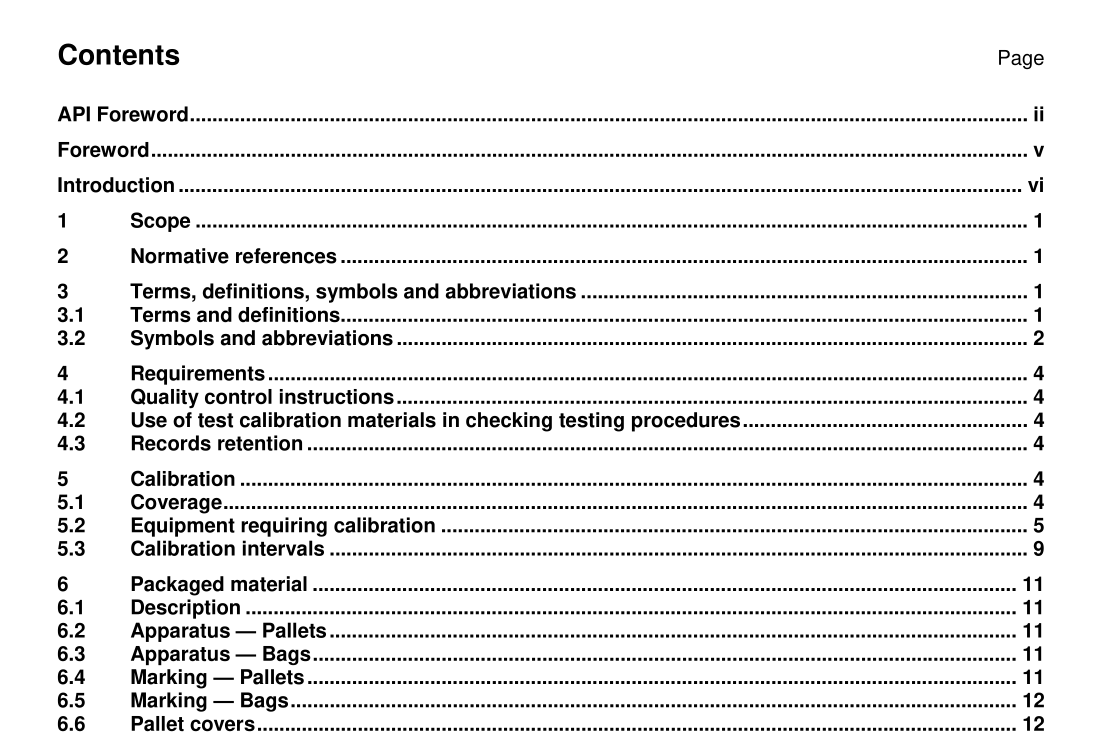API SPEC 13A pdf download

API SPEC 13A pdf download.Petroleum and natural gas industries一Drilling fluid materials – Specifications and tests
4 Requirements
4.1 Quality control instructions All quality control work shall be controlled by manufacturer’s documented instructions, which include appropriate methodology and quantitative or qualitative acceptance criteria. 4.2 Use of test calibration materials in checking testing procedures 4.2.1 Test Calibration Barite and Test Calibration Bentonite can be obtained by contacting the API1). The calibration test materials are shipped in a 7,6 I (2 gal) plastic container. 4.2.2 The API office will forward the request to the designated custodian for further handling. The test calibration products is furnished with a certificate of calibration giving the established values for each property and the confidence limits within which a laboratory’s results shall fall. 4.2.3 The custodian shall furnish a certificate of analysis for each sample. 4.2.4 For calibration requirements of API test calibration materials, refer to 5.2.11 and 5.3.10. 4.2.5 API standard evaluation base clay (formerly OCMA base clay; not OCMA grade bentonite): stocks of API standard evaluation base clay have been set aside and can be ordered through the API. 4.3 Records retention AIll records specified in this International Standard shall be maintained for a minimum of five years from the date of preparation.
5 Calibration
5.1 Coverage 5.1.1. Clause 5 covers calibration procedures and calibration intervals for laboratory equipment and reagents specified. For laboratory items not listed, the manufacturer shall develop procedures where deemed appropriate. 5.1.2 The manufacturer shall control, calibrate, verify, and maintain the laboratory equipment and reagents used in this International Standard for measuring product conformance to International Standard requirements. 5.1.3 The manufacturer shall maintain and use laboratory equipment and reagents in a manner such that measurement uncertainty is known and meets required measurement capability. 5.1.4 . The manufacturer shall document and maintain calibration procedures, including details of laboratory equipment and reagent type, identification number, frequency of checks, acceptance criteria, and corrective action to be taken when results are unsatisfactory. 5.1.5 The manufacturer shall establish and document responsibility for administration of the calibration program, and responsibility for corrective action. 5.1.6 The manufacturer shall document and maintain calibration records for laboratory equipment and reagents; shall periodically review these records for trends, sudden shifts or other signals of approaching malfunction; and shall identify each item with a suitable indicator or approved identification record to show calibration status.
5.2 Equipment requiring calibration
5.2.1 Volumetric glassware Laboratory volumetric glassware used for final acceptance, including Le Chatelier flasks, pipettes, and burettes, are usually calibrated by the supplier. Manufacturers of products to this International Standard shall document evidence of glassware calibration prior to use. Supplier certification is acceptable. Calibration may be checked gravimetrically. Periodic recalibration is not required. 5.2.2 L aboratory thermometers 5.2.2.1 The manufacturer shall calibrate all laboratory thermometers used in measuring product conformance to standards against a secondary reference thermometer. The secondary reference thermometer shall show evidence of calibration as performed against NIST certified master instruments, in accordance with the procedures outlined by ASTM E77 and NBS (NIST) Monograph 150. 5.2.2.2 . Calibration – – – Thermometers 5.2.2.2.1 Place thermometer to be calibrated side by side with secondary reference thermometer into a constant- temperature water bath (or suitable container of 4| or more, flled with water, on a counter in a constant- temperature room) and allow to equilibrate for at least 1 h. 5.2.2.2.2 Read both thermometers and record readings. 5.2.2.2.3 Repeat readings throughout at least a 1-h interval to obtain a minimum of four readings. 5.2.2.2.4 Calculate the average and the range of readings for each thermometer. The difference between the range of the readings for each thermometer shall not exceed士0,1 °C (士0,2 °F), or the smallest scale division on the thermometer being calibrated.









